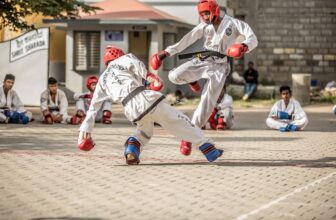Have you ever wondered what it takes to master the art of taekwondo? It’s not just about learning how to kick and punch – there’s a whole world of intricate techniques and moves waiting to be explored.
From powerful hand strikes to lightning-fast kicks, taekwondo offers a dynamic range of skills that can both impress and protect.
In this article, we’ll delve into the exciting world of some of the best taekwondo moves, giving you a glimpse of the exhilarating techniques that define this martial art.
So get ready to be captivated by the artistry and power of taekwondo as we uncover the secrets behind its unique techniques.
Basics of Taekwondo Moves
Taekwondo moves encompass a wide range of techniques, including hand strikes, kicks, blocks, patterns, and self-defense techniques. Hand strikes can be executed in various ways and have different targets on the opponent’s body.
Different styles of hand strikes exist, some of which are prohibited in Taekwondo competitions. Taekwondo kicks include the front kick, side kick, roundhouse kick, back kick, reverse side kick, and hook kick. Other kicks, such as the axe kick, jump spin kick, crescent kick, and reverse turning kick, are also incorporated.
Blocks play a crucial role in Taekwondo, with techniques like the Single Forearm Block, Low Block, Rising Block, Palm Block, and Knife Hand Block being utilized. Patterns, or poomsae, involve a series of movements sequenced together.
Taekwondo self-defense techniques encompass various techniques such as linear and circular movements, pressure point applications, throwing techniques, joint locks, termination techniques, choking techniques, and freeing techniques.
These self-defense techniques are evaluated in competition demonstrations based on factors like realism, precision, knowledge diversity, and difficulty.
Mastering Taekwondo moves and styles requires advanced knowledge of the following:
- Hand strikes vary in style and target different areas of the opponent’s body.
- Taekwondo kicks include front kicks, side kicks, roundhouse kicks, and more.
- Blocks play a crucial role in Taekwondo, providing defense against attacks.
- Patterns, or poomsae, are a series of movements linked together in a prescribed sequence.
- Taekwondo self-defense techniques involve a range of techniques for various situations.
Self-defense techniques are evaluated in competition demonstrations based on realism, precision, knowledge diversity, and difficulty.
History and Origins Behind Taekwondo Moves
Taekwondo, a martial art known for its striking and kicking techniques, has a rich history that dates back to the 1940s in Korea. But did you know that the moves we see today are the result of a blend of ancient Korean martial arts, as well as influences from Chinese and Japanese martial arts?
In the 1940s and 1950s, Korean martial artists who had experience in Karate, Chinese martial arts, and indigenous Korean martial arts such as Taekkyon, Subak, and Gwonbeop, began to develop what we now know as Taekwondo. The name “Taekwondo” itself translates to “the way of the foot and fist”, and it was coined in the 1950s as various Kwans (martial arts schools) sought to unify Korean martial arts under a single system.
One of the pivotal moments in Taekwondo’s history was in 1952 when South Korean president Syngman Rhee witnessed a martial arts demonstration by Korean army officers and was inspired to integrate martial arts into the military. This led to the formation of the Korea Taekwondo Association (KTA) in 1959, which played a significant role in the unification and standardization of Taekwondo techniques.
Taekwondo’s emphasis on high kicks, spinning jump kicks, and fast kicking techniques is a defining characteristic. The martial art also incorporates a philosophy that focuses on mental and ethical discipline, respect, and self-confidence.
In 1973, the World Taekwondo Federation was established to promote Taekwondo as a sport. Taekwondo made its Olympic debut as a demonstration sport in 1988 and became an official Olympic sport in 2000.
Today, Taekwondo is practiced worldwide, and its moves continue to evolve. The martial art is not just about fighting; it’s also a way of life that cultivates both physical and mental strength.
Taekwondo techniques vary between schools and levels
It is important to note that Taekwondo techniques can vary between different schools and levels of training. Each school may have its own curriculum and teaching style, which can result in variations in the execution of techniques.
As practitioners progress in their training and attain higher belt ranks, they are introduced to more advanced and complex techniques.
Hand strikes in Taekwondo
Hand strikes are an integral part of Taekwondo and can be performed in various ways. These include standing strikes, jumping strikes, spinning strikes, and rushing forwards.
Hand strikes are used for both offensive and defensive purposes in combat situations.
Different styles of hand strikes
In Taekwondo, different styles of hand strikes target specific areas on the opponent’s body. Some common hand strikes include punches, palm strikes, and knife hand strikes.
These strikes can be executed with precision and speed, making them effective tools in a fight.
Banned hand strikes in Taekwondo competitions
The following hand strikes are banned in Taekwondo competitions and general sparring:
- Strikes to the groin area
- Eye gouging
- Striking the back of the head
- Strikes to the throat
- Attacks to the neck
Various kicks in Taekwondo
Taekwondo is renowned for its wide array of kicks. Some of the most commonly used kicks include the front kick, side kick, roundhouse kick, back kick, reverse side kick, and hook kick.
These kicks can be powerful and devastating when delivered with proper technique and timing.
Other Taekwondo Kicks
In addition to the basic kicks, there are several advanced kicks in Taekwondo that require a high level of skill and agility.
These include the axe kick, jump spin kick, crescent kick, and reverse turning kick. These kicks add variety and creativity to an individual’s Taekwondo repertoire.
Blocks in Taekwondo
To complement the strikes and kicks, Taekwondo also incorporates a range of blocks. Blocks are defensive maneuvers used to deflect or parry incoming attacks.
Some common blocks in Taekwondo include the Single Forearm Block, Low Block, Rising Block, Palm Block, and Knife Hand Block.
These blocks are vital for protecting oneself from an opponent’s strikes.
Taekwondo Patterns (poomsae)
Poomsae, also known as Taekwondo patterns, are a series of movements linked together in a prescribed sequence.
Practitioners perform these patterns as a way to practice and refine their techniques in a controlled manner.
Poomsae is an essential part of Taekwondo training and allows individuals to demonstrate their mastery of the art through precise execution and fluidity of movement.
Taekwondo self-defense techniques
Taekwondo is not just for sport and exercise, it also includes various self-defense techniques and can be extremely effective.
These techniques involve linear and circular movements, as well as the application of pressure points, throwing techniques, joint locks, termination techniques, choking techniques, and freeing techniques.
Taekwondo self-defense techniques teach individuals to defend themselves effectively in real-life situations.
Evaluation of self-defense techniques in competition demonstrations
During Taekwondo competitions and demonstrations, self-defense techniques are evaluated based on criteria such as realism, precision, variety of knowledge, and difficulty.
Judges assess the ability of participants to effectively execute these techniques and apply them in realistic scenarios. Mastery of self-defense techniques demonstrates a high level of skill and proficiency in Taekwondo.
As you can tell, Taekwondo offers a diverse range of moves, techniques, and skills.
From hand strikes and kicks to blocks and self-defense techniques, practitioners of Taekwondo learn a comprehensive arsenal of techniques to effectively defend themselves and compete in various forms of the martial art.
Through dedicated training and practice, individuals can master the art of Taekwondo and become skilled practitioners in this ancient martial art.
- Incorporate footwork into your taekwondo moves. Agility and quick movement can give you an advantage during sparring or self-defense situations.
- Practice combination strikes to keep your opponent off balance. Mixing up different hand strikes and kicks can make it difficult for your opponent to anticipate your next move.
- Strengthen your core muscles to improve your overall taekwondo performance. A strong core will help you generate more power in your strikes and maintain balance during kicks.
- Train your reflexes through partner drills or reaction exercises. Taekwondo requires quick reflexes and the ability to react swiftly to your opponent’s movements.
- Cross-train in other martial arts disciplines to enhance your taekwondo skills. Learning techniques from different styles can broaden your knowledge and make you a more well-rounded fighter.
Remember, the best Taekwondo moves are the ones you can perform and connect with most successfully.







